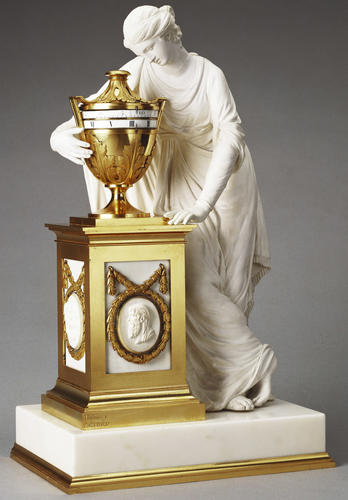Mantel clock c. 1783
Gilt bronze and enamel clock with biscuit porcelain figure on marble base | 43.0 x 25.9 x 19.9 cm (whole object) | RCIN 2827
-
Mantel clock with biscuit porcelain figure of Andromache? embracing the clock which is in the form of gilt metal urn mounted on rectangular pedestal with profile heads in relief.
Although the movement is signed by François-Justin Vulliamy, and is for that reason likely to be an early example of this popular model, the inspiration behind the development of these figural mantel clock cases was certainly that of François-Justin’s son Benjamin, and it was he who arranged with William Duesbury to improve the production of Derby biscuit porcelain by employing a series of well-trained sculptor-modellers. The so-called draped ‘Andromache’ figure was probably modelled by the young sculptor John Deare, who left the Vulliamys’ employ in 1785; it seems to be based on a composition by John Bacon, who also worked directly for Vulliamy on occasions.
The annular dial is around the chased ormolu oviform vase which Andromache embraces and mounted on a square pedestal with oval profile portrait medallions of those she is mourning. The whole is mounted on a rectangular porcelain plinth. The eight day timepiece has a fusee movement and a ½-dead beat escapement. The upper ring-dial shows the minutes in Arabic numerals, the lower ring-dial shows the hours in Roman numerals.
According to Benjamin Lewis Vulliamy, grandson of François-Justin, George III’s version of this clock, which varied in some small details from this one, was ‘the first of this pattern . . . & was made expressly for His late Majesty King George the 3d’. No payment for this clock is identifiable in George III’s accounts and it does not survive in the Royal Collection. A second version, owned by George IV when Prince of Wales and recorded by Benajmin Lewis Vulliamy at the Royal Pavilion, Brighton, was purchased from François-Justin Vulliamy in 1784 (£94 10s).
This example was bequeathed to Queen Victoria by Lord Melbourne in 1848.
Catalogue entry adapted from George III & Queen Charlotte: Patronage, Collecting and Court Taste, London, 2004Provenance
Bequeathed to Queen Victoria by 2nd Viscount Melbourne (1779-1848)
-
Creator(s)
(clockmaker (case))(clockmaker (case))(modeller)Acquirer(s)
-
Medium and techniques
Gilt bronze and enamel clock with biscuit porcelain figure on marble base
Measurements
43.0 x 25.9 x 19.9 cm (whole object)








